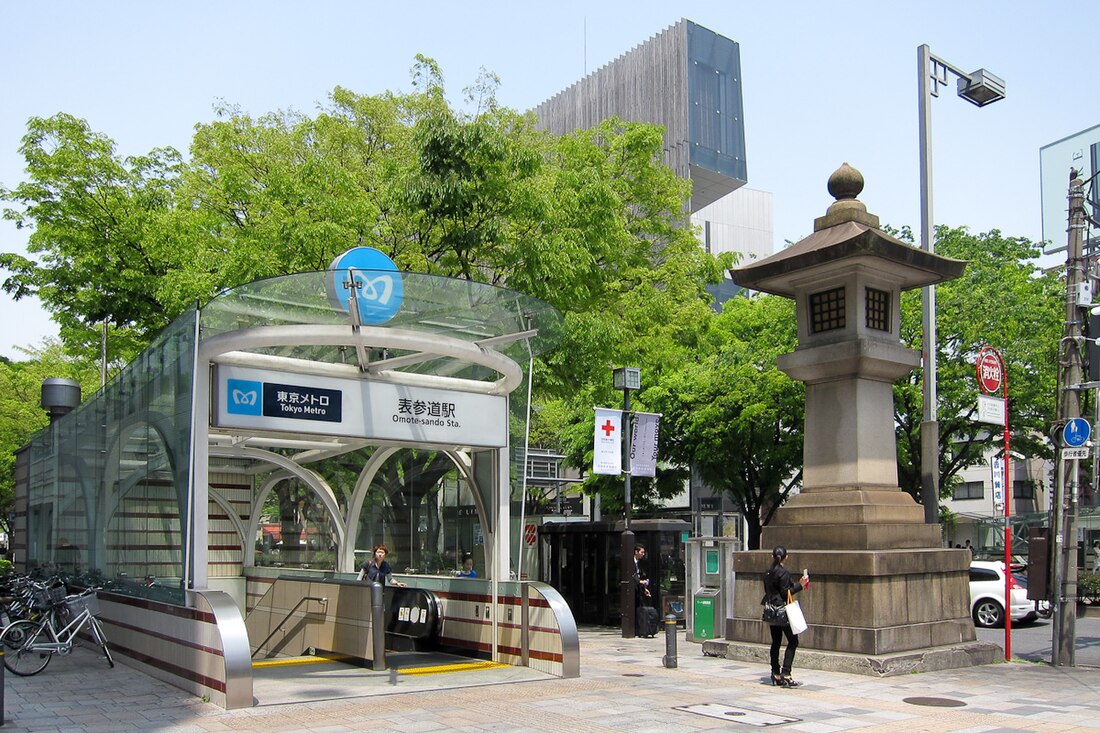Top Qs
Timeline
Chat
Perspective
Omote-sandō Station
Metro station in Tokyo, Japan From Wikipedia, the free encyclopedia
Remove ads
Omote-sando Station (表参道駅, Omote-sandō-eki) is a Tokyo Metro subway station located at the intersection of Omotesandō (Avenue Omotesandō) and Aoyama-dori (Aoyama Street) in Aoyama, Minato ward, Tokyo, Japan. Part of the Chiyoda Line platforms extends into Shibuya ward.
This article relies largely or entirely on a single source. (January 2015) |
Remove ads
Lines
Omote-sando Station is served by the following three lines.
- Tokyo Metro Chiyoda Line (C-04)
- Tokyo Metro Ginza Line (G-02)
- Tokyo Metro Hanzomon Line (Z-02)
Station layout
There are three levels at this station:
- B1: Ginza and Hanzomon Line platforms
- B2: Ticket hall / ticket gates / main concourse
- B3: Chiyoda Line platforms
All platforms are wheelchair accessible. There is same-direction cross-platform interchange between the Ginza and Hanzomon lines, making this a convenient transfer point on the Aoyama-dōri section of these lines. Passengers who wish to change to the JR lines or the Keio Inokashira Line at Shibuya often change to the Ginza line here; those who want the Tokyu Toyoko Line, the Tokyo Metro Fukutoshin Line or the Tokyu Den-en-toshi Line often change to the Hanzomon Line. While both the west-bound Ginza and Hanzomon Line goes to Shibuya station, they have separate fare control area at Shibuya, making transfers inconvenient.
- Chiyoda Line Concourse, 2018
Remove ads
Platforms
The Chiyoda Line station has one island platform and two tracks. The Ginza/Hanzomon Lines station has two island platforms and four tracks. There are same-direction cross-platform interchanges in the Ginza/Hanzomon Lines station.
| 1 | C Chiyoda Line | for Meiji-jingumae and Yoyogi-uehara |
| 2 | C Chiyoda Line | for Otemachi, Kita-senju, Ayase, and Kita-ayase JL Joban Line (Local) for Matsudo, Kashiwa and Toride (via Ayase) |
| 3 | Z Hanzōmon Line | for Shibuya DT Den-en-toshi Line for Chūō-Rinkan |
| 4 | G Ginza Line | for Shibuya |
| 5 | G Ginza Line | for Akasaka-mitsuke, Ginza, Ueno, and Asakusa |
| 6 | Z Hanzomon Line | for Otemachi and Oshiage TS Tobu Skytree Line for Tōbu-Dōbutsu-Kōen TI Tobu Isesaki Line for Kuki TN Tōbu Nikkō Line for Minami-Kurihashi |
- Chiyoda Line Platform, 2021
- Cross-platform interchange between Ginza Line and Hanzomon Line, 2022
History
Summarize
Perspective
The station was opened as the terminus of the Tokyo Rapid Railway from Toranomon as Aoyama-rokuchōme Station (青山六丁目駅) on November 18, 1938, at a site approx. 180 m southwest of its current location (between the current station and Shibuya Station). It became a through station later that year when the section to Shibuya opened on December 20. When through services from the Tokyo Underground Railway (from Asakusa) began on September 16, 1939, the station became Jingūmae Station (神宮前駅).[2] This makes it the only Tokyo Metro station to have been renamed twice.[when?]
The Chiyoda Line platforms at Omotesando Station opened on October 20, 1972; the Omotesando name was used to avoid confusion with Meiji-Jingūmae Station, the next stop on the Chiyoda Line toward Yoyogi-Uehara. From 1972 to 1977, Omotesando and Jingumae were separate stations for the Chiyoda and Ginza lines respectively. In 1977, the Ginza Line moved to a temporary station on the northeast side of Omotesando Station, pending completion of the Hanzomon Line platforms. The new platforms for the Hanzomon Line and Ginza Line opened on August 1, 1978. The space used for the old Jingumae Station remains visible from the Ginza Line tunnel as of 2015.[2]
Scenes of the 2003 film Lost in Translation were filmed there at the Hanzōmon and Ginza lines platform.[3]
The station facilities were inherited by Tokyo Metro after the privatization of the Teito Rapid Transit Authority (TRTA) in 2004.[4]
PASMO smart card coverage at this station began operation on 18 March 2007.[5]
Remove ads
Surrounding area
- Omotesandō, Aoyama and Harajuku area
- Aoyama Gakuin
- Headquarters of the United Nations University
- Nezu Museum
- Chōkoku-ji (長谷寺), also known as Azabu Ō-Kannon (麻布大観音) (Sōtō-shū temple) - located in Nishi-Azabu
References
External links
Wikiwand - on
Seamless Wikipedia browsing. On steroids.
Remove ads




